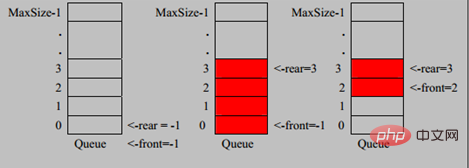

Idea analysis:

1. Adjust the meaning of the front variable: front points to the first element of the queue, In other words, arr[front] is the first element of the queue.
The initial value of front = 0
2. The meaning of the rear variable is adjusted: rear points to the last element of the queue. The latter position. Because we hope to free up a space as a convention
rear's initial value = 0
3. When the queue is full, the condition is (rear 1) % maxSize == front [ Full】
4. The conditions for the queue to be empty, rear == front empty
5. When we analyze it like this, the number of valid data in the queue (rear maxSize - front) % maxSize // rear = 1 front = 0
6. We can modify the original queue to get a circular queue
java related video tutorial sharing:java learning video
Code implementation:
import java.util.Scanner; public class CircleArrayQueueDemo { public static void main(String[] args) { //测试一把 System.out.println("测试数组模拟环形队列的案例~~~"); // 创建一个环形队列 CircleArray queue = new CircleArray(4); //说明设置4, 其队列的有效数据最大是3 char key = ' '; // 接收用户输入 Scanner scanner = new Scanner(System.in);// boolean loop = true; // 输出一个菜单 while (loop) { System.out.println("s(show): 显示队列"); System.out.println("e(exit): 退出程序"); System.out.println("a(add): 添加数据到队列"); System.out.println("g(get): 从队列取出数据"); System.out.println("h(head): 查看队列头的数据"); key = scanner.next().charAt(0);// 接收一个字符 switch (key) { case 's': queue.showQueue(); break; case 'a': System.out.println("输出一个数"); int value = scanner.nextInt(); queue.addQueue(value); break; case 'g': // 取出数据 try { int res = queue.getQueue(); System.out.printf("取出的数据是%d\n", res); } catch (Exception e) { // TODO: handle exception System.out.println(e.getMessage()); } break; case 'h': // 查看队列头的数据 try { int res = queue.headQueue(); System.out.printf("队列头的数据是%d\n", res); } catch (Exception e) { // TODO: handle exception System.out.println(e.getMessage()); } break; case 'e': // 退出 scanner.close(); loop = false; break; default: break; } } System.out.println("程序退出~~"); } } class CircleArray { private int maxSize; // 表示数组的最大容量 //front 变量的含义做一个调整: front 就指向队列的第一个元素, 也就是说 arr[front] 就是队列的第一个元素 //front 的初始值 = 0 private int front; //rear 变量的含义做一个调整:rear 指向队列的最后一个元素的后一个位置. 因为希望空出一个空间做为约定. //rear 的初始值 = 0 private int rear; // 队列尾 private int[] arr; // 该数据用于存放数据, 模拟队列 public CircleArray(int arrMaxSize) { maxSize = arrMaxSize; arr = new int[maxSize]; } // 判断队列是否满 public boolean isFull() { return (rear + 1) % maxSize == front; } // 判断队列是否为空 public boolean isEmpty() { return rear == front; } // 添加数据到队列 public void addQueue(int n) { // 判断队列是否满 if (isFull()) { System.out.println("队列满,不能加入数据~"); return; } //直接将数据加入 arr[rear] = n; //将 rear 后移, 这里必须考虑取模 rear = (rear + 1) % maxSize; } // 获取队列的数据, 出队列 public int getQueue() { // 判断队列是否空 if (isEmpty()) { // 通过抛出异常 throw new RuntimeException("队列空,不能取数据"); } // 这里需要分析出 front是指向队列的第一个元素 // 1. 先把 front 对应的值保留到一个临时变量 // 2. 将 front 后移, 考虑取模 // 3. 将临时保存的变量返回 int value = arr[front]; front = (front + 1) % maxSize; return value; } // 显示队列的所有数据 public void showQueue() { // 遍历 if (isEmpty()) { System.out.println("队列空的,没有数据~~"); return; } // 思路:从front开始遍历,遍历多少个元素 for (int i = front; i < front + size() ; i++) { System.out.printf("arr[%d]=%d\n", i % maxSize, arr[i % maxSize]); } } // 求出当前队列有效数据的个数 public int size() { // rear = 2 // front = 1 // maxSize = 3 return (rear + maxSize - front) % maxSize; } // 显示队列的头数据, 注意不是取出数据 public int headQueue() { // 判断 if (isEmpty()) { throw new RuntimeException("队列空的,没有数据~~"); } return arr[front]; } }
Related article tutorial sharing:java quick start
The above is the detailed content of Using arrays to implement circular queues in java. For more information, please follow other related articles on the PHP Chinese website!